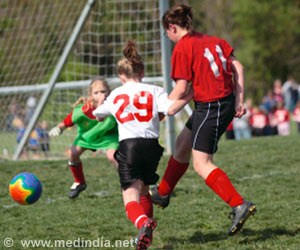
‘With extra training sessions in the sports hall and more matches on the program, youth handball players risk getting shoulder injuries.’
Tweet it Now
But a sudden increase in the amount of training and matches has
crucial importance for children and young people getting shoulder
injuries. This is shown by a new PhD project from Aarhus University,
which is the first study globally to have looked into the correlation
between load from both training and competition and the development of
shoulder injuries.The project has been carried out by the former elite handball player and PhD Merete Møller in collaboration with researchers from Aarhus University, the University of Southern Denmark and the Oslo Sports Trauma Research Center.
Data from almost 700 youth handball players aged 14-18 years who were monitored through the 31 weeks of a handball season forms the basis for the results, which have now been published in the British Journal of Sports Medicine.
During the weeks in question the players provided information via text message on e.g. their injuries, amount of training and matches. A total of 106 new shoulder injuries were reported during the 73,546 hours of competition and training time.
Worrying results
Advertisement
"It is worrying that so many players either have or develop shoulder problems at such an early age, and it is therefore crucial that we learn more about why players develop these injuries, so that we can reduce the number," says Merete Møller.
Advertisement
"This means that if you play an average of five hours a week over a period of four weeks, then you should play a maximum of eight hours during the next week. If you have not played for more than two hours over the past four weeks, for example due to injury or illness, you should be more cautious and not increase the competition and training load to more than 3.2 hours in the week where you next feel you can train and play at full strength again," says Merete Møller.
Training must be adjusted
The results also point to players with reduced shoulder strength or reduced control of their shoulder blade being more vulnerable to shoulder injuries. These players had an increased risk of shoulder injuries if they increased their weekly level of training and competition by 20 to 60%.
"If a player with either reduced strength or reduced control of the shoulder blade plays an average of five hours a week for a four-week period, our study suggests that they should play a maximum of six to eight hours per week afterwards by comparison," says Merete Møller, and adds:
"In a time where there is a lot of talk about how hard the fixture list is for senior players, it is important to remember that very many youth handball players also have an unreasonably hard competition and training program, and that the adults around them, both parents and trainers, must be better to adjust their competition and training load."
In 1997, she became double World Champion at both youth and national team level, and Merete Møller was called one of the biggest talents in Danish women's handball. But the promising career did not last long. At the age of 21 she was already declared to be invalid as a handball player and she has not played since. Today she carries out research into handball injuries and how to prevent them.
Source-Eurekalert











